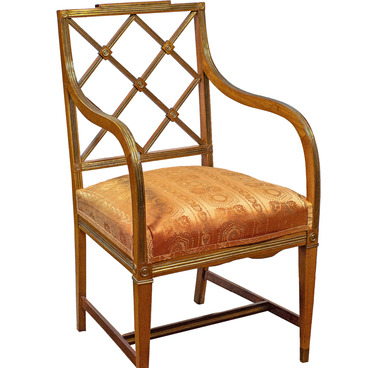In the 18th century, tea and coffee became popular in Western Europe, and factories began to produce different types of sets for one (solitaire or egoist), two (tete-a-tete), or several persons (cabaret). Such sets included cups and saucers, a coffee pot or teapot, a sugar bowl, a milk jug — all this could be placed on a porcelain tray. Soon, the vogue for such sets came to Russia.
Franz Gardner’s factory, founded in the 18th century, was the first privately-owned porcelain factory in Russia. The workshops were located in the village of Verbilki, Dmitrovsky district, Moscow Governorate. The factory received numerous awards and prizes for its products at various exhibitions.
Francis Gardner, the founder, was originally from the English county of Staffordshire. He came to Russia in 1746, changed his name to Franz and settled in St. Petersburg. At first, Gardner was involved in the timber industry and then switched to sugar production. He made a lot of money from the sugar business and he managed to arrange the marriages of his children to the representatives of honorable noble families.
Before opening his porcelain factory, Gardner visited almost every corner of Russia, from Solovki to Siberia, in search of the necessary clay. He found a suitable option in Little Russia — in the Chernihiv region of Ukraine. Gardner planned to arrange a local porcelain supply for the country, so that there would be no need to buy porcelain from abroad, for example, the expensive Meissen porcelain. In March 1766, the official opening of the factory took place. Along with exclusive production for the imperial palaces and houses of the highest nobility, Gardner also launched mass production of porcelain tableware, which was considered the best in Russia.
In 1833, the factory started to produce earthenware, and in the 1840s — tableware made of opaque, which is considered the highest grade of faience. Gardner’s porcelain was the gold standard for other private Russian factories. Nowadays, there is Gardner Lane in the center of Moscow — a street in the Basmanniy District between Bolshoy Demidovsky Lane and Baumanskaya Street.
The museum’s collection contains a coffee set for one person, including a coffee pot with a lid, a tray, a milk jug, a sugar bowl, a cup and a saucer. At the bottom of the coffee pot, there is a red stamp confirming the authenticity. This mark was placed during the heyday of production in the years 1870–1890. It depicts a rider on a horse, a two-headed eagle, as well as has the Russian inscriptions of the name of the owner of the plant and the location — “Въ Москве” (In Moscow).
Franz Gardner’s factory, founded in the 18th century, was the first privately-owned porcelain factory in Russia. The workshops were located in the village of Verbilki, Dmitrovsky district, Moscow Governorate. The factory received numerous awards and prizes for its products at various exhibitions.
Francis Gardner, the founder, was originally from the English county of Staffordshire. He came to Russia in 1746, changed his name to Franz and settled in St. Petersburg. At first, Gardner was involved in the timber industry and then switched to sugar production. He made a lot of money from the sugar business and he managed to arrange the marriages of his children to the representatives of honorable noble families.
Before opening his porcelain factory, Gardner visited almost every corner of Russia, from Solovki to Siberia, in search of the necessary clay. He found a suitable option in Little Russia — in the Chernihiv region of Ukraine. Gardner planned to arrange a local porcelain supply for the country, so that there would be no need to buy porcelain from abroad, for example, the expensive Meissen porcelain. In March 1766, the official opening of the factory took place. Along with exclusive production for the imperial palaces and houses of the highest nobility, Gardner also launched mass production of porcelain tableware, which was considered the best in Russia.
In 1833, the factory started to produce earthenware, and in the 1840s — tableware made of opaque, which is considered the highest grade of faience. Gardner’s porcelain was the gold standard for other private Russian factories. Nowadays, there is Gardner Lane in the center of Moscow — a street in the Basmanniy District between Bolshoy Demidovsky Lane and Baumanskaya Street.
The museum’s collection contains a coffee set for one person, including a coffee pot with a lid, a tray, a milk jug, a sugar bowl, a cup and a saucer. At the bottom of the coffee pot, there is a red stamp confirming the authenticity. This mark was placed during the heyday of production in the years 1870–1890. It depicts a rider on a horse, a two-headed eagle, as well as has the Russian inscriptions of the name of the owner of the plant and the location — “Въ Москве” (In Moscow).



